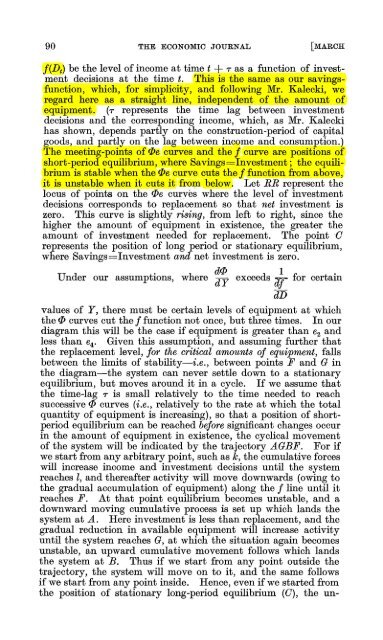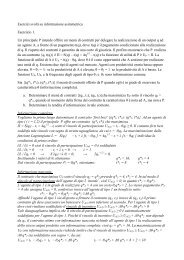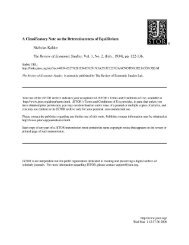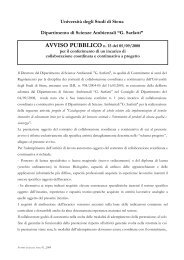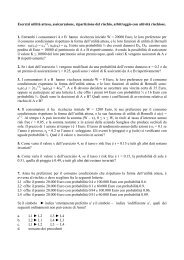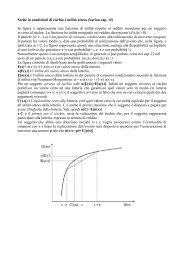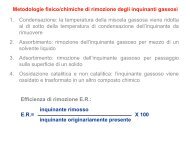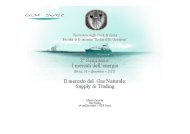A Model of the Trade Cycle Author(s): Nicholas Kaldor Source: The ...
A Model of the Trade Cycle Author(s): Nicholas Kaldor Source: The ...
A Model of the Trade Cycle Author(s): Nicholas Kaldor Source: The ...
- No tags were found...
You also want an ePaper? Increase the reach of your titles
YUMPU automatically turns print PDFs into web optimized ePapers that Google loves.
90 TRE EcONOMIe JOURNAL [MARCRf(D t ) be <strong>the</strong> level <strong>of</strong> income at time t + 7 as a function <strong>of</strong> investmentdecisions at <strong>the</strong> time t. This is <strong>the</strong> same as our savingsfunction,which, for simplicity, and following Mr. Kalecki, weregard here as a straight line, independent <strong>of</strong> <strong>the</strong> amount <strong>of</strong>equipment. (7 represents <strong>the</strong> time lag between investmentdecisions and <strong>the</strong> corresponding income, which, as Mr. Kaleckihas shown, depends partly on <strong>the</strong> construction-period <strong>of</strong> capitaIgoods, and partly on <strong>the</strong> lag between income and consumption.)<strong>The</strong> meeting-points <strong>of</strong> @e curves and <strong>the</strong> f curve are positions <strong>of</strong>short-period equilibrium, where Savings==lnvestment; <strong>the</strong> equilibriumis stable when <strong>the</strong> @e curve cuts <strong>the</strong>f function from above,it is unstable when it cuts it fro~ ,below. Let RR represent <strong>the</strong>locus <strong>of</strong> points on <strong>the</strong> @e cu:r;yes where <strong>the</strong> level <strong>of</strong> investmentdecisions corresponds to replacement so that net investment iszero. This curve is slightly rising, from left to right, since <strong>the</strong>higher <strong>the</strong> amount <strong>of</strong> equipment in existence, <strong>the</strong> greater <strong>the</strong>amount <strong>of</strong> investment needed for replacement. <strong>The</strong> point ,Orepresents <strong>the</strong> position <strong>of</strong> long period or stationary equilibrium,where Savings==lnvestment and net investment is zero.Under our assumptions, where ~~ exceeds d~ for certaindDvalues <strong>of</strong> Y, <strong>the</strong>re must be certain levels <strong>of</strong> equipment at which<strong>the</strong> @ curves cut <strong>the</strong>f function not once, but three times. In ourdiagram this will be <strong>the</strong> case if equipment is greater than e 2andless than e 4 • Given this assumption, and assuming fur<strong>the</strong>r .that<strong>the</strong> replacement level, for <strong>the</strong> critical amounts <strong>of</strong> equipment, fallsbetween <strong>the</strong> limits <strong>of</strong> stability-i.e., between points F and G in<strong>the</strong> diagram-<strong>the</strong> system can never settle down to a stationaryequilibrium, but moves around it in a cycle. If we assume that<strong>the</strong> time-Iag 7 is small relatively to <strong>the</strong> time needed to reachsuccessive @ curves (i.e., relatively to <strong>the</strong> rate at which <strong>the</strong> totalquantity <strong>of</strong> equipment is increasing), so that a position <strong>of</strong> shortperiodequilibrium can be reached before significant changes occurin <strong>the</strong> amount <strong>of</strong> equipment in existence, <strong>the</strong> cyclical movement<strong>of</strong> <strong>the</strong> system will be indicated by <strong>the</strong> trajectory AGBF. For ifwe start from any arbitrary point, such as k, <strong>the</strong> cumulative forceswill increase income and investment decisions until <strong>the</strong> systemreaches l, and <strong>the</strong>reafter activity will move downwards (owing to<strong>the</strong> graduaI accumulation <strong>of</strong> equipment) along <strong>the</strong> f line until itreaches F. At that point equilibrium becomes unstable, and adownward moving cumulative process is set up whièh lands <strong>the</strong>system at A. Here investment is less than replacement, and <strong>the</strong>graduaI reduction iI1- available equipment will increase activityuntil <strong>the</strong> system reaches G, at which <strong>the</strong> situation again becomesunstable, a,n upward cumulative movement follows which lands<strong>the</strong> system at B. Thus if we start from any point outside <strong>the</strong>trajectory, <strong>the</strong> system will move on to it, and <strong>the</strong> same followsif we start from any point inside. Hence, even if we started from<strong>the</strong> position <strong>of</strong> stationary long-period equilibrium (O), <strong>the</strong> un-


